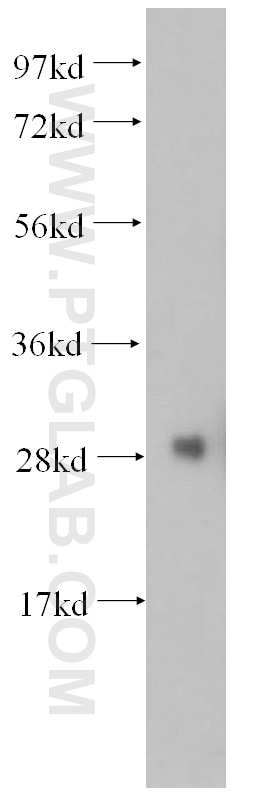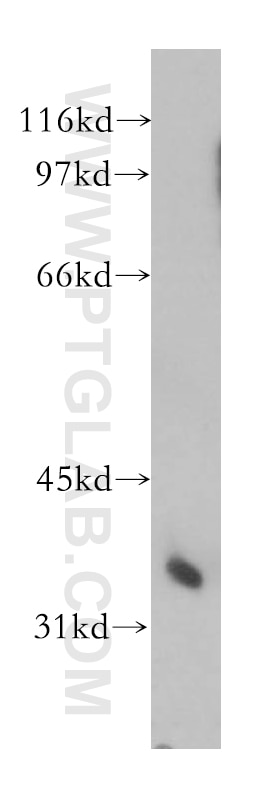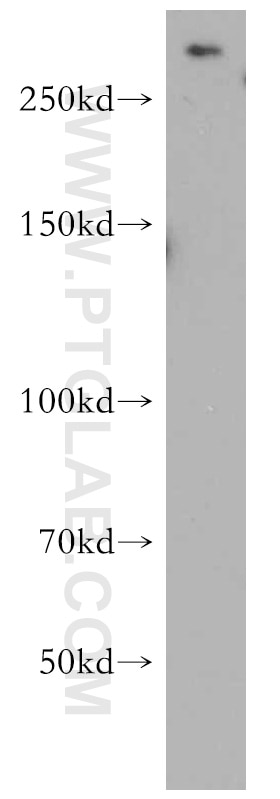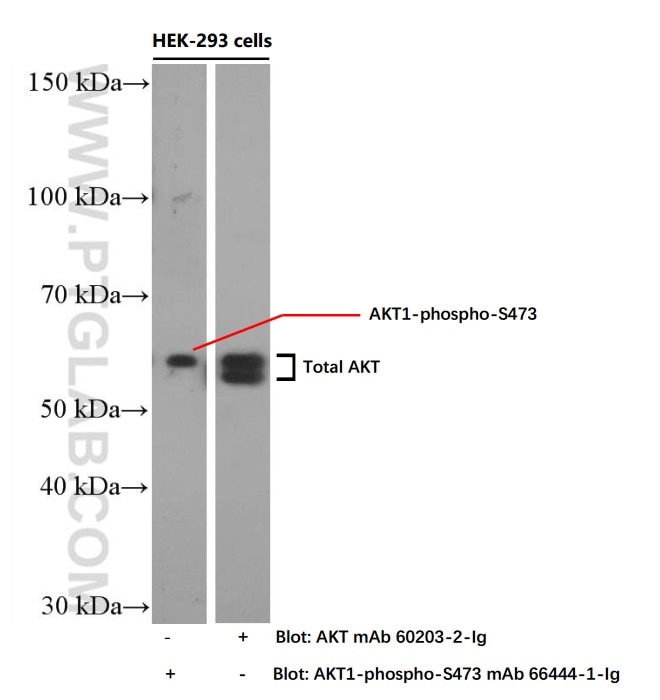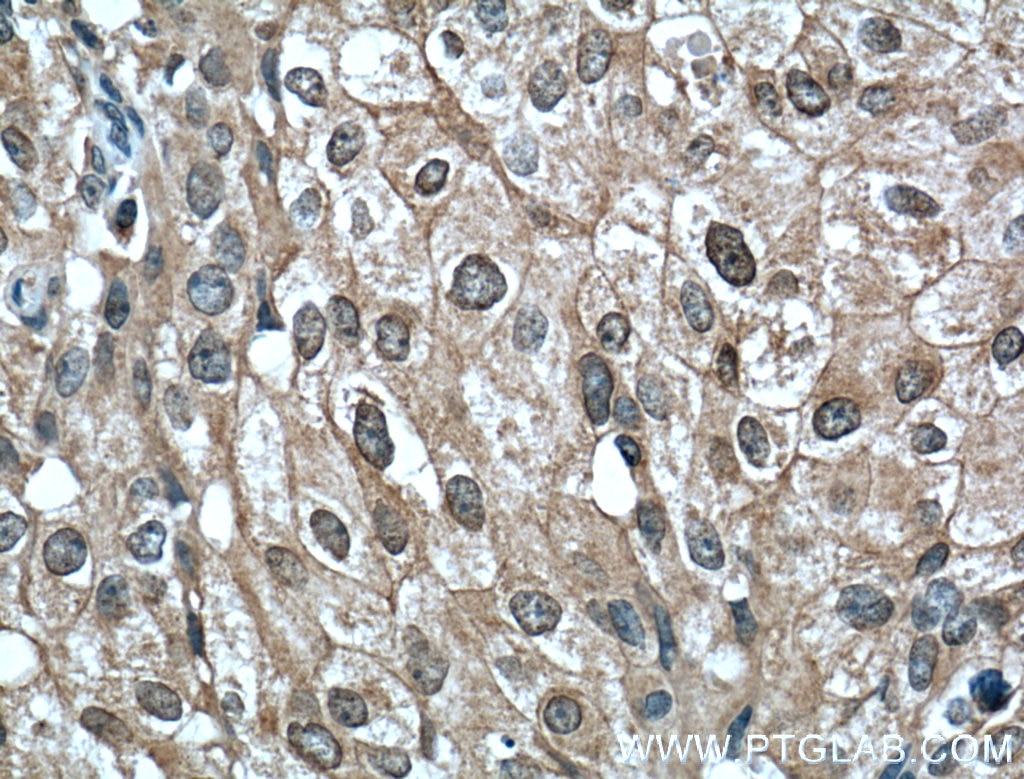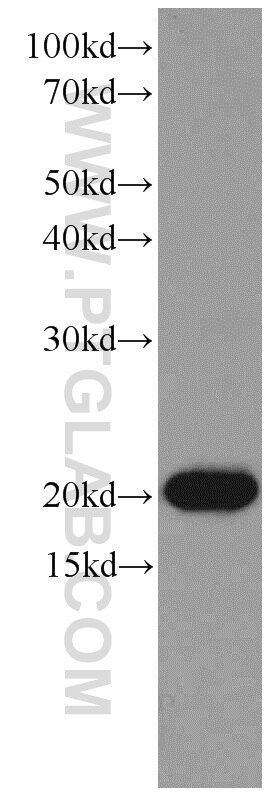- Featured Product
- KD/KO Validated
p70(S6K) Polyklonaler Antikörper
p70(S6K) Polyklonal Antikörper für FC, IF, IHC, IP, WB, ELISA
Wirt / Isotyp
Kaninchen / IgG
Getestete Reaktivität
human, Maus, Ratte und mehr (3)
Anwendung
WB, IP, IHC, IF, FC, ELISA
Konjugation
Unkonjugiert
Kat-Nr. : 14485-1-AP
Synonyme
Galerie der Validierungsdaten
Geprüfte Anwendungen
| Erfolgreiche Detektion in WB | HEK-293-Zellen, C6-Zellen, HeLa-Zellen, Jurkat-Zellen, Maushirngewebe, Mit IGF-1 behandelte MCF-7-Zellen, NIH/3T3-Zellen, PC-12-Zellen, Rattenhirngewebe |
| Erfolgreiche IP | HeLa-Zellen |
| Erfolgreiche Detektion in IHC | humanes Leberkarzinomgewebe Hinweis: Antigendemaskierung mit TE-Puffer pH 9,0 empfohlen. (*) Wahlweise kann die Antigendemaskierung auch mit Citratpuffer pH 6,0 erfolgen. |
| Erfolgreiche Detektion in IF | HepG2-Zellen |
| Erfolgreiche Detektion in FC | HepG2-Zellen |
Empfohlene Verdünnung
| Anwendung | Verdünnung |
|---|---|
| Western Blot (WB) | WB : 1:2000-1:8000 |
| Immunpräzipitation (IP) | IP : 0.5-4.0 ug for 1.0-3.0 mg of total protein lysate |
| Immunhistochemie (IHC) | IHC : 1:50-1:500 |
| Immunfluoreszenz (IF) | IF : 1:10-1:100 |
| Durchflusszytometrie (FC) | FC : 0.20 ug per 10^6 cells in a 100 µl suspension |
| It is recommended that this reagent should be titrated in each testing system to obtain optimal results. | |
| Sample-dependent, check data in validation data gallery | |
Veröffentlichte Anwendungen
| KD/KO | See 2 publications below |
| WB | See 140 publications below |
| IHC | See 3 publications below |
| IF | See 2 publications below |
Produktinformation
14485-1-AP bindet in WB, IP, IHC, IF, FC, ELISA p70(S6K) und zeigt Reaktivität mit human, Maus, Ratten
| Getestete Reaktivität | human, Maus, Ratte |
| In Publikationen genannte Reaktivität | human, Hausschwein, Kaninchen, Maus, Ratte, Riesenscheibenbrasse (Megalobrama amblycephala) |
| Wirt / Isotyp | Kaninchen / IgG |
| Klonalität | Polyklonal |
| Typ | Antikörper |
| Immunogen | p70(S6K) fusion protein Ag5883 |
| Vollständiger Name | ribosomal protein S6 kinase, 70kDa, polypeptide 1 |
| Berechnetes Molekulargewicht | 59 kDa |
| Beobachtetes Molekulargewicht | 65-75 kDa, 80-85 kDa |
| GenBank-Zugangsnummer | BC053365 |
| Gene symbol | RPS6KB1 |
| Gene ID (NCBI) | 6198 |
| Konjugation | Unkonjugiert |
| Form | Liquid |
| Reinigungsmethode | Antigen-Affinitätsreinigung |
| Lagerungspuffer | PBS mit 0.02% Natriumazid und 50% Glycerin pH 7.3. |
| Lagerungsbedingungen | Bei -20°C lagern. Nach dem Versand ein Jahr lang stabil Aliquotieren ist bei -20oC Lagerung nicht notwendig. 20ul Größen enthalten 0,1% BSA. |
Hintergrundinformationen
RPS6KB1(Ribosomal protein S6 kinase beta-1) is also named as STK14A, p70 S6KA, and belongs to the S6 kinase subfamily. RPS6KB1 is a major substrate of mTOR and acts as a crucial effector of mTOR signaling pathway. It plays a key role in cell growth and proliferation by regulating INS sensitivity, metabolism, protein synthesis, and cell cycle. RPS6KB1 may play an important role in the progression of HCC and could serve as a potential molecular target for HCC therapy (PMID:22684641). The Rps6kb1 gene encodes the 70 kDa ribosomal protein S6 kinase (p70S6K). The PI3K/mTOR signalling pathway is one of the major mechanisms for controlling cell survival, proliferation, and metabolism and is the central regulator of translation of some components of the protein synthesis system. Due to alternative translation, two isoform S6K1 proteins are known to exist in mammalian cells: p85 S6K1 and p70 S6K1, which is identical to p85 S6K but lacks its first 23 amino acids. In addition, mammalian cells express a second S6K1 isoform spanning 316 amino acids (p31 S6K1).
Protokolle
| Produktspezifische Protokolle | |
|---|---|
| WB protocol for p70(S6K) antibody 14485-1-AP | Protokoll herunterladen |
| IHC protocol for p70(S6K) antibody 14485-1-AP | Protokoll herunterladen |
| IF protocol for p70(S6K) antibody 14485-1-AP | Protokoll herunterladen |
| IP protocol for p70(S6K) antibody 14485-1-AP | Protokoll herunterladen |
| FC protocol for p70(S6K) antibody 14485-1-AP | Protokoll herunterladen |
| Standard-Protokolle | |
|---|---|
| Klicken Sie hier, um unsere Standardprotokolle anzuzeigen |
Publikationen
| Species | Application | Title |
|---|---|---|
Cell Stem Cell Amino acid catabolism regulates hematopoietic stem cell proteostasis via a GCN2-eIF2α axis. | ||
Small Methods PROTAC Degraders of Androgen Receptor-Integrated Dissolving Microneedles for Androgenetic Alopecia and Recrudescence Treatment via Single Topical Administration | ||
Cell Death Differ Lysine methylation of PPP1CA by the methyltransferase SUV39H2 disrupts TFEB-dependent autophagy and promotes intervertebral disc degeneration | ||
Redox Biol Aberrant hyper-expression of the RNA binding protein GIGYF2 in endothelial cells modulates vascular aging and function | ||
Autophagy SMCR8 negatively regulates AKT and MTORC1 signaling to modulate lysosome biogenesis and tissue homeostasis. |
-Antibody-14485-1-AP-WB-268098.jpg)
-Antibody-14485-1-AP-WB-484367.jpg)
-Antibody-14485-1-AP-WB-428140.jpg)
-Antibody-14485-1-AP-WB-180462.jpg)
-Antibody-14485-1-AP-IP-35809.jpg)
-Antibody-14485-1-AP-IHC-252307.jpg)
-Antibody-14485-1-AP-IF-17645.jpg)
-Antibody-14485-1-AP-IF-408919.jpg)
-Antibody-14485-1-AP-FC-38056.jpg)
